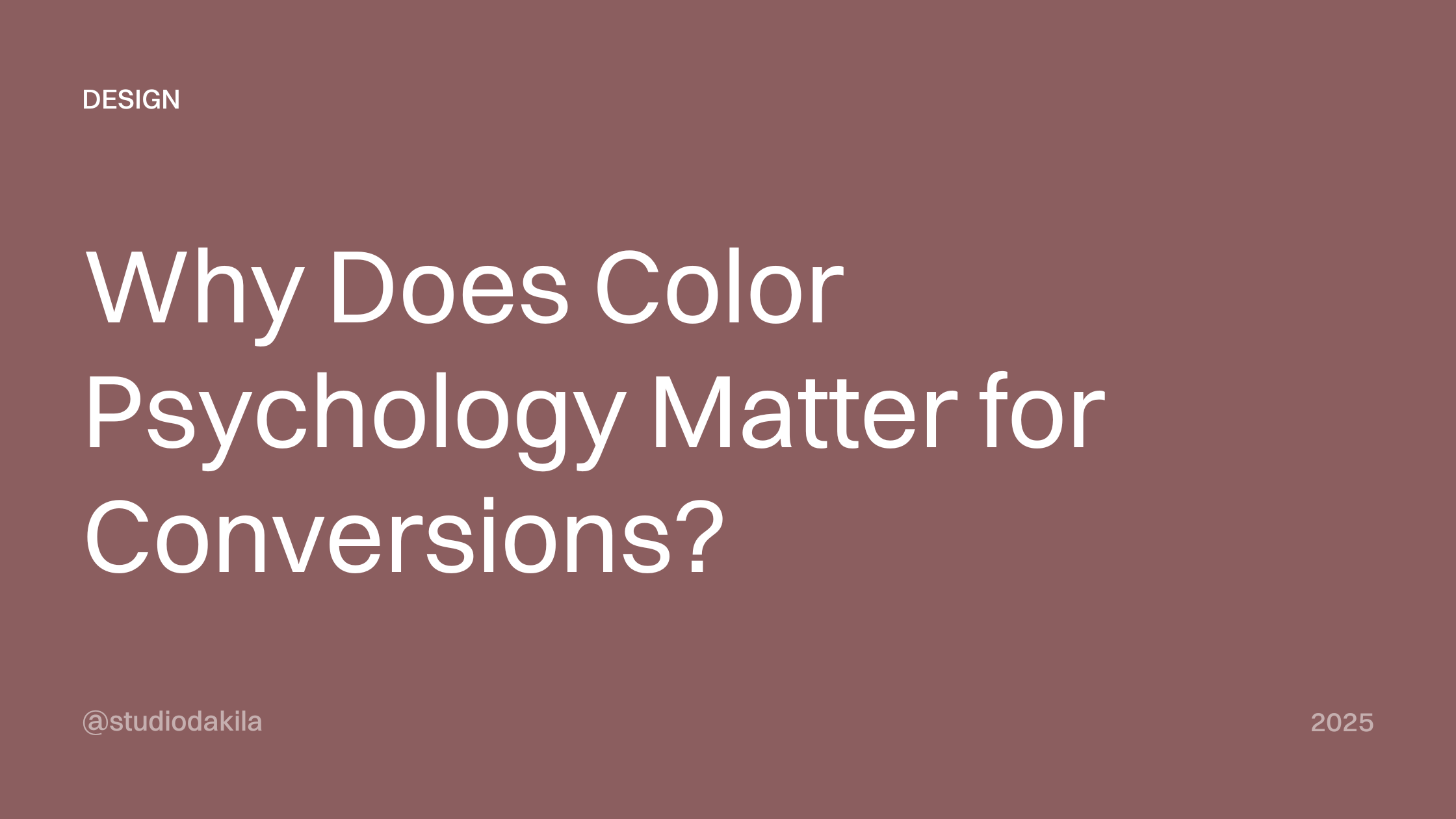Key Takeaways:
- Color psychology influences 90% of initial product judgments, making it a strategic conversion tool rather than just aesthetic choice
- Context-aware color implementation that maps to user emotional journeys increases engagement and reduces cognitive load throughout the experience
- Balancing accessibility standards with psychological effectiveness creates inclusive designs that perform better for all users
Color psychology shapes split-second judgments about digital experiences before we even realize we’re judging.
The color of a button shapes that choice.
Most designers treat color as a branding decision or an aesthetic preference. That approach misses the deeper mechanism at work. Color psychology operates at the psychological level, triggering emotional responses that directly influence user behavior, engagement, and conversion.
The data makes this clear. Nearly 90% of initial judgments made about products are based on color alone. Before users read your copy, evaluate your features, or consider your offer, they’ve already formed an impression based on your color choices.
That’s not decoration. That’s strategic territory.
How Color Psychology Shapes User Perception
Color psychology in UI/UX design operates on both conscious and unconscious levels. Users might consciously recognize that blue feels trustworthy or that red creates urgency. But the deeper impact happens below awareness, where color influences mood, perception, and decision-making without explicit recognition.
Think about how you respond to different interfaces throughout your day. The calm focus you feel in a productivity app with muted blues and grays. The excitement and urgency of a sale notification in bright red. The welcoming warmth of an orange call-to-action button.
These responses aren’t accidental.
Research from 1.2 million A/B tests reveals that red and orange buttons generate 32-40% higher click rates compared to other colors. That’s a measurable business impact from a single design decision.
The mechanism works through learned associations and biological responses. Red triggers attention because we’ve evolved to notice it as a signal of importance, whether danger or reward. Orange balances that urgency with approachability. Blue activates associations with stability and trust, making it the dominant choice for financial and healthcare interfaces.
But here’s where it gets more interesting. Context shapes these responses dramatically.
Color in Context Matters More Than Color Alone
The same color can evoke completely different responses depending on surrounding elements, user expectations, and cultural background. Color-in-Context theory demonstrates that situation, both physical and psychological, determines emotional response more than the color itself.
A red button on a banking app might trigger anxiety. The same red on a fitness app signals energy and motivation.
This context-dependency means effective color strategy requires understanding your users’ emotional journey through your interface. Where are they coming from? What mindset do they bring? What action do you need them to take? What emotion supports that action?
An emotional journey maps the user’s emotional experience when interacting with your product. People move through conscious and subconscious emotional reactions as they progress from discovery to decision to completion. Strategic color implementation supports these transitions.
Consider a checkout flow. Early stages benefit from calming colors that reduce purchase anxiety. The final confirmation might use celebratory colors that reinforce positive feelings about the decision. Each stage serves a different emotional need.
This adaptive approach moves beyond static color schemes toward dynamic implementation that responds to user progression.
Why Color Psychology Must Include Universal Design
Strategic color implementation must account for the full spectrum of human color perception. Approximately 8% of men and 0.5% of women are affected by some form of color blindness, most commonly red-green color blindness.
Designing with accessibility in mind creates more inclusive experiences while improving overall usability for all users. When you can’t rely solely on color to convey information, you develop clearer visual hierarchies and more intuitive interfaces.
This constraint often produces better design.
Proper color selection can increase information retention by up to 78% and reduce errors by as much as 20%. These improvements benefit everyone, not just users with color vision deficiencies. Higher contrast ratios improve readability in bright sunlight. Clear visual hierarchies help users process information faster regardless of viewing conditions.
The technical implementation matters here. WCAG guidelines provide specific contrast ratio requirements for text and interactive elements. Meeting these standards isn’t just about compliance. It’s about ensuring your color psychology actually works for your entire audience.
Emotional Journey Mapping Through Color
The most sophisticated color strategies map directly to user emotional states throughout the experience. This requires understanding both the psychology of color and the emotional arc of your user journey.
Start by identifying the key emotional states your users experience. Are they anxious when they first arrive? Excited? Confused? Overwhelmed? Each state suggests different color strategies.
For anxious users, calming blues and greens reduce stress and encourage exploration. For excited users, vibrant colors maintain energy without overwhelming. For confused users, clear contrast and simple color hierarchies reduce cognitive load.
The progression matters as much as individual states. Moving a user from anxiety to confidence requires different color transitions than moving them from curiosity to decision.
Dynamic and adaptive color schemes respond to these progressions automatically. Dark mode reduces eye strain in low-light conditions, extending session times and improving comfort. Personalized color preferences let users customize their experience based on individual needs and preferences.
Many UX consultants now recommend adaptive palettes as part of comprehensive digital service offerings. This responsive approach enhances user comfort while reducing cognitive load, leading to longer engagement and higher conversion rates.
Practical Implementation Strategies
Understanding color psychology means little without clear implementation strategies. Here’s how to translate theory into practice.
Start with audience research. Blue might be universally popular, but younger audiences often respond more strongly to yellow while older demographics find it less appealing. Cultural background shapes color associations dramatically. White signals purity in Western contexts but represents mourning in some Eastern cultures.
Digital marketing agencies Philippines and other regional specialists understand these cultural nuances deeply, making localization a critical factor in global design strategies. Know who you’re designing for before you choose your palette.
Map your emotional journey. Identify the key touchpoints in your user experience and the emotional state you want to support at each point. Discovery might need curiosity and openness. Decision points need confidence and clarity. Completion needs satisfaction and validation.
Choose colors that support each emotional goal.
Test systematically. A/B testing reveals how your specific audience responds to different color choices in your specific context. What works for one interface might fail in another. What succeeds with one demographic might alienate another.
Let data guide refinement.
Consider mobile context. Mobile users process visual information 52% faster than desktop users, making color decisions even more critical for smaller screens. Increasing contrast ratios by 35% above desktop standards leads to 28% better readability in bright sunlight.
Companies that outsource website design often overlook these mobile-specific color considerations, leading to suboptimal user experiences. Optimize for the actual viewing conditions your users face.
Balance brand consistency with psychological effectiveness. Your brand colors create recognition and consistency. But forcing brand colors into contexts where they undermine user psychology creates friction. Find the balance between brand expression and psychological support.
Sometimes the best brand expression comes from knowing when to step back.
The Technical-Creative Balance
Effective color psychology implementation requires both technical precision and creative intuition. The technical side involves contrast ratios, accessibility standards, color theory fundamentals, and systematic testing. The creative side involves understanding emotional nuance, cultural context, and the subtle ways color combinations create meaning.
Most design practices separate these skills. Technical designers focus on standards and measurements. Creative designers focus on aesthetics and emotion. But the most effective color strategies integrate both approaches seamlessly.
The impact of AI on UX design is making this integration more accessible, with tools that can analyze color performance while preserving creative intent. This integration mirrors the broader challenge in digital marketing and UX design. Data-driven decisions need human context to create meaningful experiences. Creative intuition needs data validation to ensure effectiveness.
The goal isn’t choosing between technical and creative approaches. It’s developing the capacity to move fluidly between both modes, letting each inform and strengthen the other. A boutique agency approach often excels here, combining specialized expertise with personalized attention to both technical precision and creative vision.
Moving Forward with Strategic Color
Color psychology in UI/UX design represents far more than aesthetic preference or brand expression. It’s a strategic tool that directly influences user behavior, emotional response, and business outcomes.
The most effective implementations understand color as part of a larger system. User emotional journeys, accessibility requirements, cultural contexts, and business goals all shape optimal color choices. No single color works in all contexts. No palette succeeds for all audiences.
Strategic color implementation requires continuous learning, systematic testing, and willingness to challenge assumptions. What worked last year might not work today. What succeeds for competitors might fail for your specific audience.
Start by understanding your users’ emotional journey through your interface. Identify the key emotional states and transitions. Map color strategies to support each phase. Test systematically. Refine based on data.
The technical knowledge matters. Understanding contrast ratios, color theory, and accessibility standards provides the foundation. But the real skill comes from integrating that technical precision with deep understanding of human psychology and behavior.
That integration creates digital experiences that feel intuitive, engaging, and emotionally resonant. Not because they follow design trends or copy successful competitors, but because they align color psychology with authentic user needs at every touchpoint.
The result is interfaces that users don’t just see. They feel.
And that feeling drives the decisions we’re ultimately designing for.
Ready to Transform Your Digital Experience?
Strategic color implementation requires both expertise and nuanced understanding of user psychology. If you’re looking to create interfaces that convert through thoughtful design, we can help.
Frequently Asked Questions
Color psychology in UX design is the strategic use of colors to influence user emotions, behaviors, and decision-making based on psychological associations and cultural contexts.
Research shows that strategic color choices can increase conversion rates by 32-40%, with red and orange buttons consistently outperforming other colors in A/B tests.
The most effective approach balances both—maintaining brand recognition while adapting color implementation to support user emotions and actions at specific touchpoints.
Follow WCAG contrast ratio guidelines, avoid relying solely on color to convey information, and test your designs with color blindness simulators to ensure inclusivity.
Yes, color associations are heavily influenced by cultural context—for example, white represents purity in Western cultures but mourning in some Eastern cultures, making localization essential.

